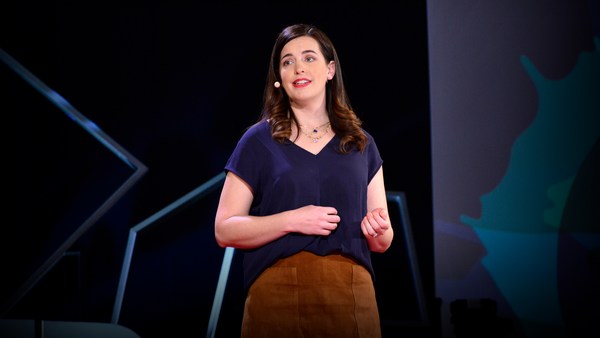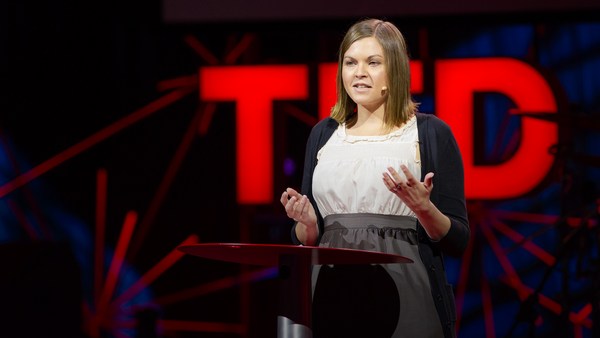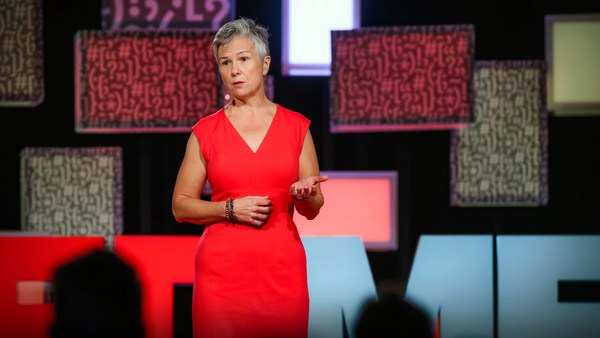When we're young, we're innocently brave, and we fearlessly dream about what our lives might be like. Maybe you wanted to be an astronaut or a rocket scientist. Maybe you dreamed of traveling to every continent. Since I was very young, I dreamed of working for the United Nations in some of the most difficult countries in the world. And thanks to a lot of courage that dream came true.
But here's the thing about courage: it doesn't just appear whenever we need it. It's the result of tough reflection and real work, involving the balance between fear and bravery. Without fear, we'll do foolish things. And without courage, we'll never step into the unknown. The balance of the two is where the magic lies, and it's a balance we all deal with every day.
First, a word about my fancy wheels. I haven't always used a wheelchair. I grew up like many of you, running, jumping and dancing. I love to dance. However, in my mid-twenties, I began to experience a series of inexplicable falls. And a few years later, I was diagnosed with a recessive genetic condition called hereditary inclusion body myopathy, or HIBM. It's a progressive muscle wasting disease that affects all of my muscles from head to toe. HIBM is very rare. In the United States there are less than 200 people diagnosed. To date, there is no proved treatment or cure, and within 10 to 15 years of its onset, HIBM typically leads to quadriplegia, which is why I now use a wheelchair.
When I was first diagnosed, everything changed. It was frightening news because I had no experience with chronic illness or disabilities. And I had no idea how the disease might progress. But what was most disheartening was to listen to other people advise me to limit my ambitions and dreams, and to change my expectations of what to expect from life. "You should quit your international career." "No one will marry you this way." "You would be selfish to have children." The fact that someone who wasn't me was putting limitations on my dreams and ambitions was preposterous. And unacceptable. So I ignored them.
(Cheers and applause)
I did get married. And I decided for myself not to have children. And I continued my career with the United Nations after my diagnosis, going to work for two years in Angola, a country recovering from 27 years of brutal civil war. However, it would be another five years until I officially declared my diagnosis to my employer. Because I was afraid that they would question my capacity to manage and I'd lose my job. I was working in countries where polio had been common, so when I overheard someone say that they thought I might have survived polio, I thought my secret was safe. No one asked why I was limping. So I didn't say anything.
It took me over a decade to internalize the severity of HIBM, even as basic tasks and functions became increasingly difficult. Yet, I continued to pursue my dream of working all over the world, and was even appointed as a disability focal point for UNICEF in Haiti, where I served for two years after the devastating 2010 earthquake. And then my work brought me to the United States. And even as the disease progressed significantly and I needed leg braces and a walker to get around, I still longed for adventure. And this time, I started dreaming of a grand outdoor adventure. And what's more grand than the Grand Canyon?
Did you know that for every five million people who visit the Rim only one percent go down to the canyon's base? I wanted to be a part of that one percent. The only thing is --
(Applause)
The only thing is that the Grand Canyon isn't exactly accessible. I was going to need some assistance to get down the 5,000-foot descent of vertical loose terrain. Now, when I face obstacles, fear doesn't necessarily immediately set in because I assume that one way or another, I'll figure it out. And in this case, my thought was, well, if I can't walk down, I could learn to ride a horse. So that's what I did.
And with that fateful decision began a four-year commitment, tossing back and forth between fear and courage to undertake a 12-day expedition. Four days on horseback to cross Grand Canyon rim to rim, and eight days rafting 150 miles of the Colorado River, all with a film crew in tow. Spoiler alert -- we made it. But not without showing me how my deepest fear can somehow manifest a mirror response of equal courage. On April 13, 2018, sitting eight feet above the ground, riding a mustang horse named Sheriff, my first impression of Grand Canyon was one of shock and terror. Who knew I had a fear of heights.
(Laughter)
But there was no giving up now. I mustered up every ounce of courage inside me to not let my fear get the best of me. Embarking on the South Rim, all I could do to keep myself composed was to breathe deeply, stare up into the clouds and focus on my team's voices. But then, in the first hour, disaster struck. Unable to hold myself upright in the saddle, going down an oversized step, I flung forward and smacked my face on the back of the horse's head. There was panic, my head hurt fiercely, but the path was too narrow for us to dismount. Only at the halfway point at 2,300 feet, at least another two hours down, could we stop and remove my helmet and see the egg-sized bump protruding from my forehead. For all of that planning and gear, how is it that we didn't even have an ice pack?
(Laughter)
Luckily for all of us, the swelling came outwards, and would drain into my face as two fantastic black eyes which is an amazing way to look in a documentary film.
(Laughter)
(Applause and cheers)
This was not an easy, peaceful journey, and yet, that was exactly the point. Even though I was afraid to get back into the saddle, I got back in. The descent alone to the canyon floor took a total of 10 hours and that was just day one of four riding.
Next came the mighty rapids. The Colorado River in the Grand Canyon has some of the highest white water in the country. And just to be prepared in case we should capsize, we'd practice having me swim through a smaller rapid. And it's safe to say it wasn't glamorous.
(Laughter)
I took my breath in the wrong part of the wave, choked on river water and was unable to steer myself. Yes, it was scary, but it was also fantastic. Waterfalls, slick canyons and a couple billion years of bedrock that seemed to change color throughout the day. The Grand Canyon is true wilderness and worthy of all of its accolades.
(Applause)
The expedition, all that planning and the trip itself, showed me a level of fear I had never experienced before. But more importantly, it showed me how boldly courageous I can be. My Grand Canyon journey was not easy. This was not a vision of an Amazonian woman effortlessly making her way through epic scenery. This was me crying, exhausted and beat up with two black eyes. It was scary, it was stressful, it was exhilarating.
Now that the trip is over, it's easy to be blasé about what we achieved. I know I want to raft the river again. This time, all 277 miles of it.
(Applause)
But I also know that I would never do the horseback-riding part again.
(Laughter)
It's just too dangerous. And that's my real point. I'm not just here to show you my film footage. I'm here to remind us all that life is really just a lesson in finding the balance between fear and courage. And understanding what is and what isn't a good idea.
(Laughter)
Life is already scary, so for our dreams to come true, we need to be brave. In facing my fears and finding the courage to push through them, I swear my life has been extraordinary. So live big and try to let your courage outweigh your fear. You never know where it might take you.
Thank you.
(Applause and cheers)





